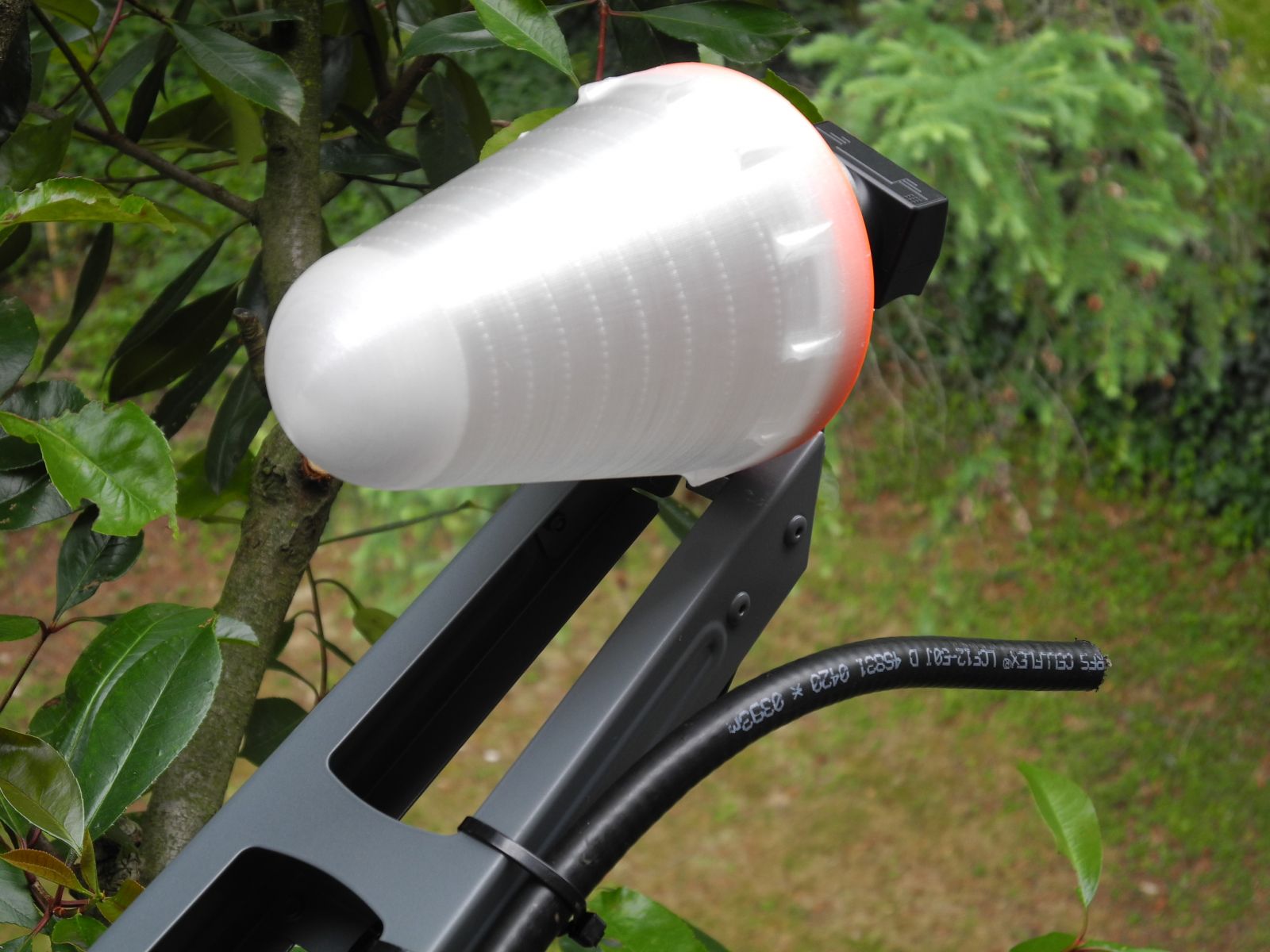
Ice Cone Feed (original DIY construction)
I am running the QO100 uplink via a DIY dual feed also known as “Ice Cone Feed” featuring a 3.5 turn helix and a standard unmodified LNB (55mm diameter).
If you have access to a 3D printer you can build it yourself. Or contact me via email and I can build a unit for you (see Ice Cone Feed v2).





CONSTRUCTION: The Ice Cone Feed consists of 3D printable parts, which can be downloaded from thingiverse (links below).
All part should be printed in PET/PETG as this is UV resistant and won’t warp at outside temperatures as PLA would.
The reflector support (below in red) will be pushed onto the LNB horn. It is designed for a standard 55mm horn diameter (59/61mm versions available as well). Print with 5-10% infill. It is secured by a clamping mechanism. An M4 bolt is inserted sideways and locks an M4 nut. Tighten the M4 bolt for clamping.
The cover is a cone with 2mm wall thickness. Print with 100% infill. A rough qualitative test did not show significant attenuation at 2.4 GHz:
https://twitter.com/i/status/1185990040159170561
The reflector is a 4mm aluminum disk, see drawing and hole pattern below Cut M4 threads for 3 bolts to secure the reflector to its support. Cut M3 threads for the N type connector. Make sure you meet the outer diameter, if the reflector is too large then the cover will get stuck when srewing it on. I don’t have a lathe to produce perfect disks. I made my reflector by rougly cutting as per below drawing (a bit oversize). Then I used a special 3D printed tool (also on thingiverse) which you can mount the reflector on (M10 bolt) and spin it on a standard column drill. Use an angle grinder to shape the reflector circular. Works like a charme, demonstrated by this gentleman: https://twitter.com/i/status/1184072011787788288
The helix consist of 10mm2 copper wire (although 16mm2 is probably better, let me know about your experiences). To help with winding a special winding tool can be printed as well. Just wind along the outer groove of the cylinder, 3.5 turns and you get a helix to spec with quite good tolerances.
The antenna is fed by a standard N-type connector.
Once the helix is finished use the helix support bracket and wind the helix into it. The bracket can be glued onto the reflector.
MATCHING: I have changed the matching strip to a vane style type. Cut a .5mm copper vane as per the dimensions below. Rotate the helix such that the end is 15mm away from the reflector.
TUNING: One way to tune the resonance to 2.4 GHz is to adjust the gap between vane and reflector at the connector side. For the Ice Cone Feed v2 the sweet spot is around 1 – 2mm. Other methods are adding copper tuning elements and chopping off bits until reaching resonance. Let me know about your experiences.


DISCLAIMER: This is an open source design for the HAM community. As such it is licensed under the Creative Commons – Attribution – Non-Commercial – No Derivatives license. You are welcome to rebuild it and use it for free for private HAM activity but you must not sell or monitarize it. Contact me for a commercial license.
DOWNLOADS: All STL files for 3D printing + pdfs and dxf for reflector hole pattern are packaged here: https://www.thingiverse.com/thing:3899461




Helix winder for different wire diameters

Lathing tool
LNB attenuation
By principle the helix antenna will blank out a certain amount of signal as it is mechanically located in front of the receiving element. A geometrical analysis illustrates why and gives a good indication of the attenuation order of magnitude.
Assume an opening angle of the LNB of 50 deg. The helix shade from the LNB phase center looks like the image below:

Within a 50 deg cone (dotted circle) there is 62% of white pixels (no shading), which relates to about
2dB attenuation.
That pretty much coincides with the measurements I did receiving QO100 with and without the helix.
Ice Cone Feed (V2)
This is an improved version for series production.
If you are not comfortable to build one yourself or do not have the right tools you can make an order via my webshop.
Please note: The Ice Cone Feed v2 comes fully assembled and tuned to 2.4GHz. It is plug and play for QO100 stations. Don’t forget to specify your LNB type and diameter in the order notes at checkout so that I can choose the right adapter.
Click below for the datasheet:

Ice Cone Feed Gallery, send me pics from your station, PSE!
Millions of IceCone fans can’t be wrong 😉
 |  |  |  |
 |  |  |  |
 |  |  |  |
 |  |  |  |
 |  |  |  |
 |  |  |  |
 |  |  |  |
 |  |  |  |
 |  |  |  |
 |  |  |  |
 |  |  |  |
 |  |  | |
 |  |  |  |
 |  |
Thx AMSAT for chosing S-Band uplink.
